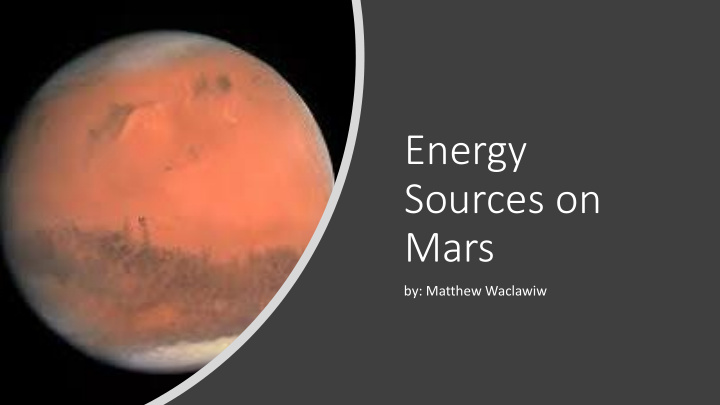



Energy Sources on Mars by: Matthew Waclawiw
• You want to wake up in the morning and think the future is going to be great - and that's what being a spacefaring civilization is all about. It's about believing in the future and thinking that the future will be better than the past. And I can't think of anything more exciting than going out there and being among the stars.” • — ELON MUSK, SPACEX Background
• To sustain a colony on Mars, energy must be readily available. • Typical U.S. residential customer consumes 10,900 kWh per year. • Much more energy would be required on Mars (for example, life support, heating, transportation, etc.) Background
Possible Sources of Energy • Wind • Solar • Nuclear • Geothermal
Wind Energy • Inefficient due to low atmospheric pressure (about 0.6% of atmospheric pressure on Earth). • Wind speeds of 98 feet/second required to produce electricity on Mars. • Would work best in areas prone to dust storms.
MARS Turbine • With each doubling in elevation, wind speed increases by 12%. • With each doubling of wind speed, power output increases by a factor of 8. • Can function at speeds grater than 63 mph, and at speeds as low as 7 mph
• According to a NASA sponsored MIT think tank, solar energy can be utilized on Mars. • 0-40 degrees North of Martian equator. • A 100 by 100 meter array could produce 100 kilowatts of energy. Solar Energy
Kilopower reactor • Sealed tube circulates fluid around sealed reactor. • Heat enters Stirling engine, which pressurizes gas to move a piston attached to a motor, producing electrical energy. • Can produce up to 10kilowatts of power.
Geothermal Energy • Requires drilling into Martian crust to find hot water reservoir. • Mars’ Cerebus plains, its Northwestern Tharsis region and the canyons of Valles Marineris are all possibilities as geothermal hotspots. • “With 500 kilowatts of nuclear power, they could start drilling and creating a 10 megawatt geothermal power supply. That would be enough for a town of 10,000 people on Earth.” -Zubrin • Mars Express Orbiter discovered water under southern polar ice caps (according to radar signal).
Recommend
More recommend